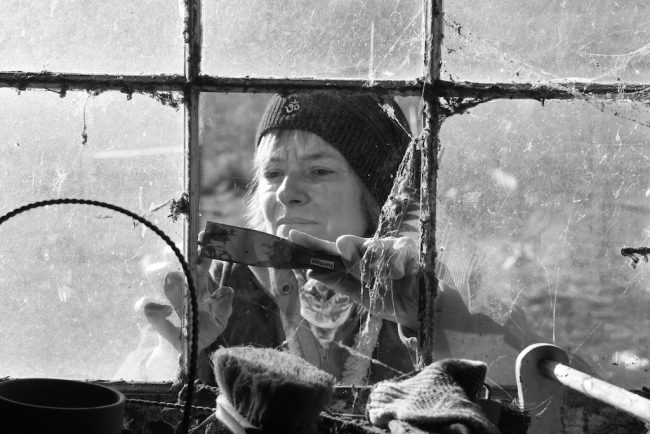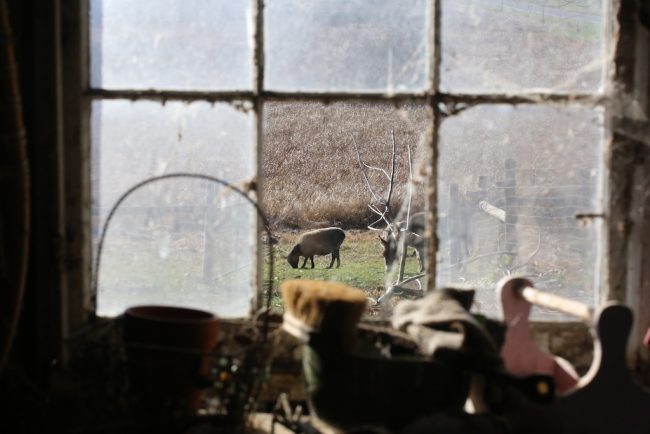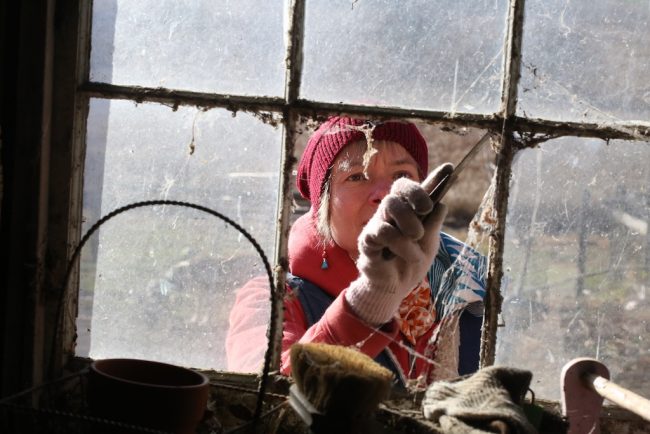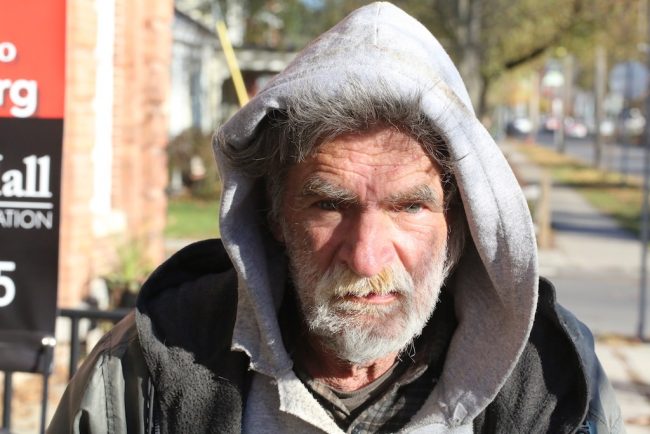
As I wrote earlier today, this is Jane Goodall day on our farm, Maria and I both seized on her as a wondrous role model in the sordid era of sexual harassment and revelation.
It seems the angry white men (and a few men of color) are making a last and smarmy stand in our time, fighting to stave off what looks more and more to me like the next chapter in a genuine revolution.
And there are many chapters in this revolution. The women’s movement is more than a century old now, and more and more, it reminds me of the trench battles in World War I, one bloody battle at a time, stretching out for many long years, now and into the future.
Maria was thrilled to go see “Jane”, Brett Morgan’s new documentary which tells Goodall’s story mostly through newly discovered 16 mm footage taken by her late ex-husband Hugo van Lawick. She saw it is a badly needed inspiration in angry and disheartening times. And it was.
Goodall’s observations of chimpanzees in what is now Tanzania were groundbreaking. They challenged conventional anthropological and medical wisdom about what was supposed to make humans exceptional and also superior to wild animals.
She is one of the most admired and remarkable woman in modern times. An untrained secretary, she came alone into the jungle to live with and observe chimpanzees, and 50 years later, she is still hard at this work, studying the chimps and fighting for the conservation of the world environment.
As women in America tell their horrifying stories of abuse and degradation, Goodall’s very life seems brighter and even more inspirational. She rejected almost all conventional ideas about how a woman was supposed to live and what choices she was supposed to make. “I don’t care what people think,” she said of her critics. And she never has.
People seeking clues to her strength and purpose could understand some of it from the scenes in the movie of her mother, who rather than fuss about the danger, urged her to go and came to the jungle with her and opened a health clinic while she was there.
She told Jane all of her life that she could do and be anything she wished to do and be.
Mothers like that seem to produce remarkable daughters.
The film is so gorgeous and absorbing that I didn’t stop and think until it was over about how much of the imagery was captured.
For one thing, this Goodall is beautiful, her blond hair clean and shiny.
She crawls through bugs and snakes and foot-long insects and the mud in the jungle, and climbs up steep and vine-infested cliffs and trees without sweating, getting a spot of mud on her khaki shorts or face or legs or converse sneakers. She never had a single hair fall out-of-place.
This in one of the hottest, most humid and dense jungles on the earth.
There is barely a scene of Goodall in her early years in Gombe when she was not sitting among the chimps or watching them. I got no sense of her life there beyond her research, or some brief shots of her raising her son Grub.
In shot after shot, Goodall is almost always sitting in a cover pose, staring meaningfully and lovingly from the tops of trees and from thick brush through cameras and binoculars. She most often looked beatific. This looked a lot like staging, and for me it demeaned what must have been years of dirty, dangerous, painstaking and frightening work.
It is not clear why the chimpanzees stayed so calm as all of the film equipment that must have been necessary came crashing through the jungle alongside of her. It makes some sense when I read that almost all of the film in the movie came from 100 hours of newly found National Geographic film archives from van Lawick.They were thought to be lost.
The original film had no sound track so all of the jungle and chimpanzee sounds were added later, the natural chronology of the film altered to fit the new narrative story line. This makes the movie, produced by National Geographic, seem disconnected at times by what can only be generously called “documentary music.”
The movie is beautiful and compelling despite all of the polishing and re-arranging. The archive footage gave Morgen the chance to construct what seems like a complete narrative. You often feel as if you are seeing a beautiful travelogue about the jungle, but are not really in it. For a documentary, that’s a problem.
Morgen’s editing shows the hard and tedious and loving work of Goodall working to win the trust of the chimpanzees and making her groundbreaking studies of their habits, emotions and brutality. The movie also draws from her letters and copious notes and charts.
Jane Goodall does add fresh interviews with Morgen and looks candidly back on her life as a researcher, mother and wife and at her work and life in the Gombe forest.
At 83, she remains a powerful charismatic presence.
It’s a tribute to Goodall’s work and life and to the quality of the film that you don’t think much about how it was put together
You are pulled along by the fascinating and sometimes heartbreaking story of this remarkable woman. Goodall discovered the chimp’s capacity for tool-making, nurturing, and stunning cruelty.
And not surprisingly, she struggled to figure out how to balance her passion for her work with her life as a mother.
I highly recommend the film, although I doubt it will be shown in many mainstream theaters. I found it especially poignant that Goodall, like so many animal lovers, initially emotionalized the chimpanzees, seeing them as having a pure, almost perfect life in paradise.
I have found that people who love animals this much often tend to emotionalize them initially, and then come to terms with reality. To truly love them is to accept them for what they are, not for what we would like them to be. Animals are not, after all, like us. Except when they are.
Goodall concedes in the film that she learned what almost all of us learn about being human, there are many wonderful things about our species too, and we all yearn for paradise. Instead we learn the hard lessons of life. We will all eventually be sick and die, and many of us are capable of almost unimaginable cruelty and brutality.
Goodall learned many significant things about chimpanzees. No one had ever studied them in detail before.
She forced the scientific world to reconsider it’s flawed and long-standing views of animals. But perhaps the most important thing she learned is that there is no perfect life, only life itself, and in that way, humans and chimpanzees are all too alike. The evolution of this wisdom is one of the real achievements of the film.
She never wavered in her determination to live her own life at a time when most women could not even consider such freedom and independence.
She married the National Geographic photographer – van Lawick – who came to record her work, and the couple had a son. When van Lawick, perhaps the most accomplished wildlife photographer ever – insisted that she leave the Gombe Forest to join him in his work photographing the Serengeti plans as his assistant – she refused and they amicably divorced.
And yes, she seems a wondrous role model for the still embattled women of today.
Goodall is a scientific hero, but also a feminist hero, and her strength and clarity are at the heart of the film..
The movie is uplifting and also sad, as life often is. This truth is gradually revealed in the movie, and Goodall has turned her focus more and more on saving the earth from the depredations of human people.
She spends most of her days now crisscrossing the world pleading on behalf of Mother Earth, and the dwindling environment left for the chimpanzees and the other animals. She knows first hand we are in danger of losing them.
Her years in the jungle may seem so much simpler to her than her newest adventure.



